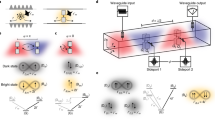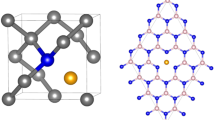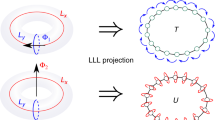Abstract
Understanding the interplay between a quantum system and its environment lies at the heart of quantum science and its applications. So far most efforts have focused on circumventing decoherence induced by the environment by either protecting the system from the associated noise1,2,3,4,5 or by manipulating the environment directly6,7,8,9. Recently, parallel efforts using the environment as a resource have emerged, which could enable dissipation-driven quantum computation and coupling of distant quantum bits10,11,12,13,14. Here, we realize the optical control of a semiconductor quantum-dot spin by relying on its interaction with an adiabatically evolving spin environment. The emergence of hyperfine-induced, quasi-static optical selection rules enables the optical generation of coherent spin dark states without an external magnetic field. We show that the phase and amplitude of the lasers implement multi-axis manipulation of the basis spanned by the dark and bright states, enabling control via projection into a spin-superposition state. Our approach can be extended, within the scope of quantum control and feedback15,16, to other systems interacting with an adiabatically evolving environment.
This is a preview of subscription content, access via your institution
Access options
Subscribe to this journal
Receive 12 print issues and online access
$259.00 per year
only $21.58 per issue
Buy this article
- Purchase on SpringerLink
- Instant access to full article PDF
Prices may be subject to local taxes which are calculated during checkout




Similar content being viewed by others
References
Konig, M. et al. Quantum spin Hall insulator state in HgTe quantum wells. Science 318, 766–770 (2007).
Press, D. et al. Ultrafast optical spin echo in a single quantum dot. Nature Photon. 4, 367–370 (2010).
Bluhm, H. et al. Dephasing time of GaAs electron-spin qubits coupled to a nuclear bath exceeding 200 μs. Nature Phys. 7, 109–113 (2011).
Weiss, K. M., Elzerman, J. M., Delley, Y. L., Miguel-Sanchez, J. & Imamoglu, A. Coherent two-electron spin qubits in an optically active pair of coupled InGaAs quantum dots. Phys. Rev. Lett. 109, 107401 (2012).
Wolfowicz, G. et al. Atomic clock transitions in silicon-based spin qubits. Nature Nanotech. 8, 561–564 (2013).
Xu, X. et al. Optically controlled locking of the nuclear field via coherent dark-state spectroscopy. Nature 459, 1105–1109 (2009).
Latta, C. et al. Confluence of resonant laser excitation and bidirectional quantum-dot nuclear-spin polarization. Nature Phys. 5, 758–763 (2009).
Foletti, S., Bluhm, H., Mahalu, D., Umansky, V. & Yacoby, A. Universal quantum control of two-electron spin quantum bits using dynamic nuclear polarization. Nature Phys. 5, 903–908 (2009).
De Lange, G. et al. Controlling the quantum dynamics of a mesoscopic spin bath in diamond. Sci. Rep. 2, 382 (2012).
Plenio, M. B., Huelga, S. F., Beige, A. & Knight, P. L. Cavity loss induced generation of entangled atoms. Phys. Rev. A 59, 2468–2475 (1999).
Diehl, S. et al. Quantum states and phases in driven open quantum systems with cold atoms. Nature Phys. 4, 878–883 (2008).
Verstraete, F., Wolf, M. M. & Cirac, J. I. Quantum computation and quantum-state engineering driven by dissipation. Nature Phys. 5, 633–636 (2009).
Lin, Y. et al. Dissipative production of a maximally entangled steady state of two quantum bits. Nature 504, 415–418 (2013).
Fogarty, T. et al. Entangling two defects via a surrounding crystal. Phys. Rev. A 87, 050304 (2013).
Mabuchi, H. & Khaneja, N. Principles and applications of control on quantum systems. Int. J. Robust Nonlinear Control 15, 647–667 (2005).
Rabitz, H. Focus on quantum control. New J. Phys. 11, 105030 (2009).
Kim, D. et al. Optical spin initialization and nondestructive measurement in a quantum dot molecule. Phys. Rev. Lett. 101, 236804 (2008).
Vamivakas, A. N. et al. Observation of spin-dependent quantum jumps via quantum dot resonance fluorescence. Nature 467, 297–300 (2010).
Delteil, A., Gao, W. B., Fallahi, P., Miguel-Sanchez, J. & Imamoglu, A. Observation of quantum jumps of a single quantum dot spin using sub-microsecond single-shot optical readout. Phys. Rev. Lett. 112, 116802 (2014).
Press, D., Ladd, T. D., Zhang, B. & Yamamoto, Y. Complete quantum control of a single quantum dot spin using ultrafast optical pulses. Nature 456, 218–221 (2008).
Merkulov, I. A., Efros, A. L. & Rosen, M. Electron spin relaxation by nuclei in semiconductor quantum dots. Phys. Rev. B 65, 205309 (2002).
Urbaszek, B. et al. Nuclear spin physics in quantum dots: An optical investigation. Rev. Mod. Phys. 85, 79–133 (2013).
Kuhlmann, A. V. et al. Charge noise and spin noise in a semiconductor quantum device. Nature Phys. 9, 570–575 (2013).
Bernard, J., Fleury, L., Talon, H. & Orrit, M. Photon bunching in the fluorescence from single molecules: A probe for intersystem crossing. J. Chem. Phys. 98, 850–859 (1993).
Fleischhauer, M., Imamoglu, A. & Marangos, J. P. Electromagnetically induced transparency: Optics in coherent media. Rev. Mod. Phys. 77, 633–673 (2005).
Xu, X. et al. Coherent population trapping of an electron spin in a single negatively charged quantum dot. Nature Phys. 4, 692–695 (2008).
Brunner, D. et al. A coherent single-hole spin in a semiconductor. Science 325, 70–72 (2009).
Besombes, L., Kheng, K., Marsal, L. & Mariette, H. Acoustic phonon broadening mechanism in single quantum dot emission. Phys. Rev. B 63, 155307 (2001).
Fu, K-M. C., Santori, C., Stanley, C., Holland, M. C. & Yamamoto, Y. Coherent population trapping of electron spins in a high-purity n-type GaAs semiconductor. Phys. Rev. Lett. 95, 187405 (2005).
Sladkov, M. et al. Electromagnetically induced transparency with an ensemble of donor-bound electron spins in a semiconductor. Phys. Rev. B 82, 121308 (2010).
Dreiser, J. et al. Optical investigations of quantum dot spin dynamics as a function of external electric and magnetic fields. Phys. Rev. B 77, 075317 (2008).
Yale, C. G. et al. All-optical control of a solid state spin using coherent dark states. Proc. Natl Acad. Sci. USA 110, 7595–7600 (2013).
Lindner, N. H. & Rudolph, T. Proposal for pulsed on-demand sources of photonic cluster state strings. Phys. Rev. Lett. 103, 113602 (2009).
Acknowledgements
We gratefully acknowledge financial support by the University of Cambridge, the European Research Council ERC Consolidator Grant agreement no. 617985, EU-FP7 Marie Curie Initial Training Network S3NANO, the NSF-funded Physics Frontier Center at the Joint Quantum Institute, and ARO MURI award no. W911NF0910406. The authors also acknowledge J. C. Barnes, G. Solomon, M. J. Stanley, R. H. J. Stockill and E. Waks for fruitful discussions and technical assistance. J.M.T. thanks the Atomic, Mesoscopic and Optical Physics Group at the Cavendish Laboratory for their fine hospitality during his stays.
Author information
Authors and Affiliations
Contributions
J.H., C.H.H.S., J.M.T. and M.A. devised the experiments. J.H., C.H.H.S. and C.L.G. performed the experiments and analysed the data. J.H., C.H.H.S., C.L.G., C.M., J.M.T. and M.A. contributed to the discussion of the results and the manuscript preparation. J.M.T. performed the theoretical modelling shown in Fig. 2. J.H. performed theoretical modelling of the data shown in Fig. 1. E.C. and M.H. grew the sample. C.M. processed the devices.
Corresponding authors
Ethics declarations
Competing interests
The authors declare no competing financial interests.
Supplementary information
Supplementary Information
Supplementary Information (PDF 1594 kb)
Rights and permissions
About this article
Cite this article
Hansom, J., Schulte, C., Le Gall, C. et al. Environment-assisted quantum control of a solid-state spin via coherent dark states. Nature Phys 10, 725–730 (2014). https://doi.org/10.1038/nphys3077
Received:
Accepted:
Published:
Issue date:
DOI: https://doi.org/10.1038/nphys3077
This article is cited by
-
Description of the non-Markovian dynamics of atoms in terms of a pure state
Computational Mathematics and Modeling (2023)
-
Integrable quantum many-body sensors for AC field sensing
Scientific Reports (2022)
-
Collapse of Dark States in Tavis–Cummings Model
Computational Mathematics and Modeling (2022)
-
Study of RbCl quantum pseudo-dot qubits using Shannon and Laplace entropies
Optical and Quantum Electronics (2020)
-
Optical Selection of Dark States of Multilevel Atomic Ensembles
Computational Mathematics and Modeling (2020)



